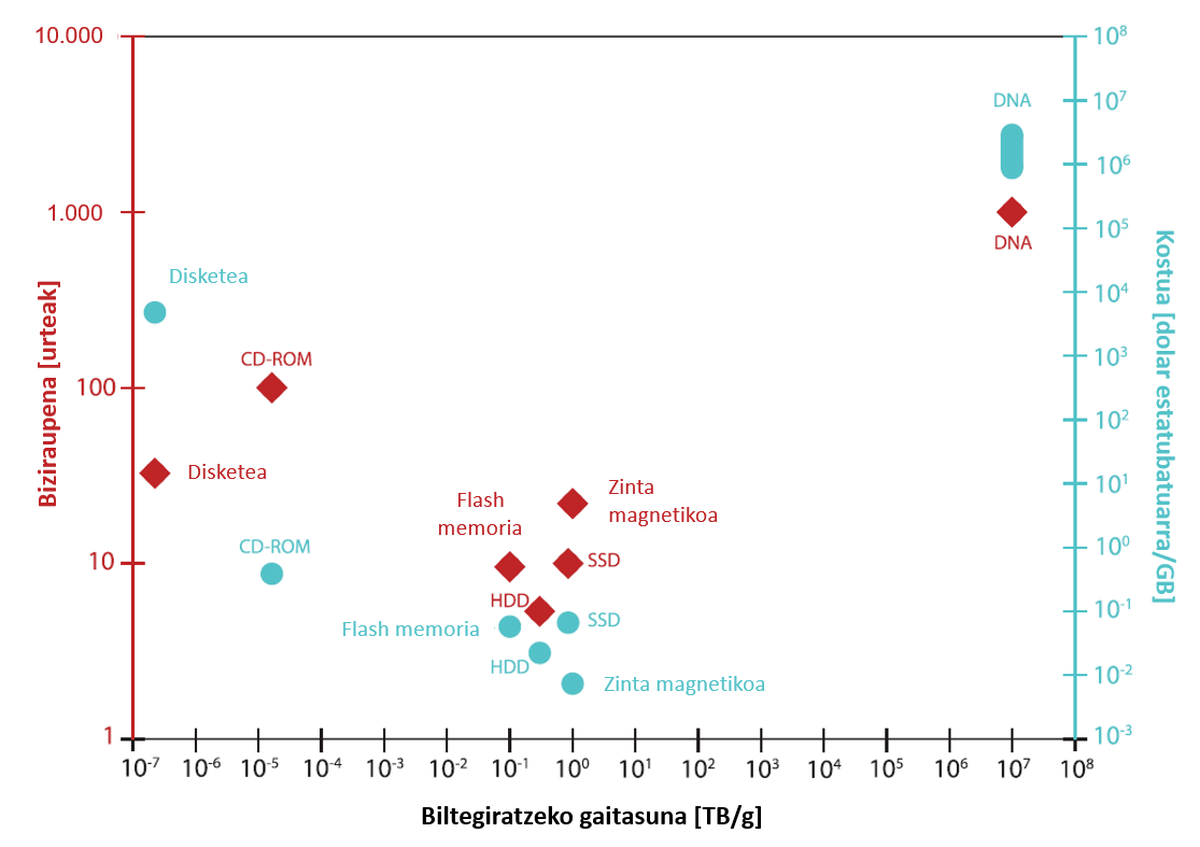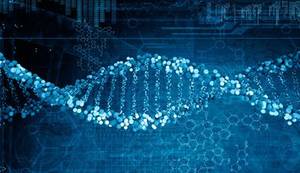What makes us, to write what we do
2023/04/26 Judith Zubia Aranburu Iturria: Elhuyar aldizkaria
Human beings have always had a special passion to transmit knowledge to future generations, which has led us to discover and/or develop some ways of storing information. So far it is known that its first evidence is among the cliffs of 40,000 years ago. Later, with the creation of languages, we produced the first written texts. Similarly, the discovery of paper and the development of the printing press made books appear for years as a source of information.
Profile change, however, XX. occurred in the mid-twentieth century, coinciding with the appearance of digital electronics. In fact, developments in the transistor and microchip allowed, among other things, the birth of digital data storage.
What is digital data storage?
Digital data storage consists of storing digital information electronically. Digital information is also expressed through the binary system (using 0 and 1). Values 0 and 1 represent situations. For example, 0 corresponds to the “off” state and 1 to the “on” state, or 0 to a particular electrical voltage and 1 to another voltage. In any case, they represent two situations. In the binary system, each of these state units is called a bit and a byte is built with 8 consecutive bits. From it, and through thousands of bytes, you build text, images, videos, audios and other digital information.
Digital data storage allows you to store large amounts of information in a reduced physical space, as well as read and edit multiple times
Spoiler: The cloud doesn't exist.
No. The “cloud” consists of data centers run by companies such as Google, Amazon Web Services (AWS), Microsoft, etc. So the cloud is a metaphor used to summarize the complexity of these infrastructures.
Let us look at the amount of data generated per day in 2022: 8.5 million searches on Google, 720,000 hours on YouTube, 93 million photos on Instagram, 867 million on Txio Using and 333 billion emails, among others. Thus, we have generated and consumed about 94 cettabytes in the last year (1 zettabyte = 1 E + 21 bytes). That is, if each bit were a coin of a euro and we accumulated coins to form 1 cettabyte, we would be making a distance of 1,970 years of light, enough for Alpha Centauri sun to reach 225 rays closer to the izar system.
In this sense, these data centers have formed some gigantic server warehouses that are organized on surfaces of about 10,000 m², in numerous columns and lines. These servers of course need a cold system to prevent overheating. In case this is not enough, and for the “cloud” to be operational at all times and the influence of failures in the electricity network is not appreciated, there are diesel generators in these areas. Thus, in one year an area of this type consumes energy equivalent to that used by 50,000 households. Faced with the growing trend of digital data storage, the energy needed to maintain this digital production would overcome the current energy consumption of the entire planet by the end of this century.
Alternatives?
One thing is clear, this is not the way. We must change direction. Find an alternative or several. It's not easy, no, but let's ask someone who knows more about survival than us, someone who has more experience than us. Let's ask nature.
How has nature managed to remember the human being or the tree from generation to generation? How has nature changed and our environment changed so that in each particular time and place we have differential characteristics? Basically, with one molecule: DNA (deoxyribonucleic acid)
When we talk about DNA, life itself comes to mind, but not information or computers. Well, the same DNA is a four-letter code for storing and transmitting information in an organism. This molecule is a double-stranded helix consisting of four nucleotides (adenine (A), thymine (T), guanine (G) and cytosine (C).
To convert digital information into DNA, the first thing you need to do is codify the data (see 1. Image). There are several ways to do this, similar to how there are several languages to write an algorithm. One option is to use adenine to express 00 of the binary system, 01 guanine, 10 cytosine and 11 thymine.
The synthesized DNA will then be stored. Although several storage systems have been developed, two strategies can be considered. An alternative would be to freeze and maintain DNA. This molecule can remain stable for millions of years under these conditions. Another possibility is to encapsulate DNA and integrate it into another material. This strategy is based on the idea of “DNA-of-Things” or “DNA of things” and basically consists in encoding information to DNA and storing it in everyday objects. One example is the work done in 2019 by researchers from Switzerland and Israel.
Reality or science fiction?
Although the use of DNA to store data is strange to us, this idea has less and less science fiction. It is a strategy that aligns very well with the challenges that we humans have for this century.
Data storage by DNA is more energy efficient and sustainable than current systems (see 3). Image), because well-encapsulated DNA can take centuries at temperature. In addition, you do not need to perform writing tasks, and files so saved can be easily copied and replicated.
If this were not enough, this storage system is very dense, as the volume occupied by the information stored by DNA is very small. In a single gram of DNA, 215 petabytes can be inserted (1 petabyte = 1 E + 15 bytes)
It should be noted, however, that data storage by DNA is still expensive, and that it will take at least a couple of decades since DNA synthesis and extraction systems drop prices and start to be widely used.
In addition, the recovery of stored files at the appropriate speed remains a challenge. In fact, each capsule used to store DNA has a DNA code that corresponds to its content as a label. Therefore, to select and extract a specific file, keeping the rest, the initiator corresponding to this DNA label must be added. With current technology, this process is very long. Data storage by DNA can, in principle, be used exclusively for the purposes of so-called “cold storage”. In other words, use only to store inactive or very unused data
A look at the future
And now imagine. Imagine a future like this. Imagine that you buy new glasses and that all the information about their graduation, material and manufacturing process is in them. Imagine that you were going to buy and that the price of each meal was the product, without the code. DNA is biodegradable and therefore inwards. Use what we've imagined to write what we do.
But imagine also what this could mean for data security and data protection. What consequences would the misuse of this technology have? What can we do? What is the responsibility of scientists and engineers for developing this technology? Like all the technological and scientific advances that have made a change of mission, it will not only generate ethical dilemmas but will question other issues.
That when it comes, it comes and it comes as it comes, at least let us not be surprised.
BIBLIOGRAPHY
[1] A. Siddiqa, A. Karim and A. Gani, “Big data storage technologies: a survey,” Frontiers of Information Technology & Electronic Engineering, vol. 18, pp. 1040-1070, 2017.
[2] I. Route, O. Ajayi, B. Akanle and R. Ahuja, “An Overview of Data Storage in Cloud Computing,” International Conference on Next Generation Computing and Information Systems (ICNGCIS), pp. 29-34, 2017.
[3] A. A. Khan and M. Zakarya, “Energy, performance and cost efficient cloud datacentres: A survey,” Computer Science Review, vol. 40, 2021.
[4] L. Ceze, J. Nivala and K. Strauss, “Molecular digital data storage using DNA,” Nature Reviews Genetics, vol. 20, pp. 456-466, 2019.
[5] And. Erlich and D. Zielinski, “DNA Fountain enables a robust and efficient storage architecture,” Science, vol. 355, pp. 950-954, 2017.
[6] J. Koch, S. Gantenbein, K. Masania, W. J. Stark, Y. Erlich and R. N. Grass, “A DNA-of-things storage architecture to create materials with embedded memory,” Nature Biotechnology, vol. 38, pp. 39-43, 2019.
[7] L. C. Meiser, B. H. Nguyen, Y.-J. Chen, J. Nivala, K. Strauss, L. Ceze and R. N. Grass, “Synthetic DNA applications in information technology,” Nature Communications, vol. 13, ez. 352, 2022.
[8] R. Heckel, “An archive written in DNA,” Nature Biotechnology, vol. 36, pp. 236-237, 2018.
[9] P. M. Church, Y. Gao and S. Kosuri “Next-Generation Digital Information Storage in DNA,” Science, vol. 337, p. 1628, 2018.
[10] C. Matange, J. M. Tuck and A. J. Keung, “DNA stability: a central design consideration for DNA data storage systems,” Nature Communications, vol. 12, ez 1358, 2021.

Gai honi buruzko eduki gehiago
Elhuyarrek garatutako teknologia








